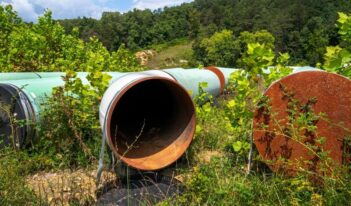
February spill raises question of whether coal ash requires federal regulation.
A recent coal ash spill in North Carolina has re-focused public attention on why final regulations have still not yet been implemented. The storage or disposal of an industrial byproduct may not usually be the most salient environmental issue debated by the general public. However, coal ash has recently come to the forefront following a historic spill of 1.1 billion gallons of coal ash sludge in Tennessee in 2008 which cost $1.2 billion to clean up and a spill currently occurring in North Carolina. The Tennessee spill sparked a debate as to whether these waste products should be regulated by individual states, as they currently are, or whether there should be federal regulation by the EPA.
Coal ash is a waste product created when coal is burned to create electricity. In the United States, according to a report released by the American Coal Ash Association, an industry trade group, power plants create approximately 110 million tons of coal ash annually. Power generators recycle about 52 million tons of ash each year, which leaves an excess of 58 million tons of coal ash per year that companies must dispose or store.
Following the 2008 coal ash spill in Tennessee, the EPA issued a proposed rule in 2010 which outlined two alternative avenues the agency could take in order to regulate coal ash and requested feedback from the public on which option would be preferable. The first option would designate coal ash as a “special waste” and require inspections for wet ash ponds, dust controls for dry ash dump sites, and the installation of liners and other safeguards at coal ash sites. However, this option would not affect older, inactive waste sites. According to the EPA, this option would cost approximately $587 million per year. Industry groups have not publicly criticized this option.
In contrast, the second option outlined by the EPA in its proposed rule has been the subject of intense industry lobbying. Instead of designating coal ash as a “special waste”, under the second option the EPA would designate coal ash as a “hazardous waste.” If coal ash were designated as a hazardous waste, the EPA would have a direct role in overseeing how coal ash is moved and disposed. Furthermore, this alternative regulatory option would require that existing waste sites be closed down and all of the coal ash be moved to newly constructed, specially designed landfills. The EPA estimates that the “hazardous waste” option would cost $1.4 billion per year.
Industry groups tend to favor the “special waste” option while environmental advocates prefer the “hazardous waste” designation. Industry groups assert that the EPA has underestimated the cost of the hazardous waste option and have released a study by the Electric Power Research Institute which indicates that over 20 years the actual cost of the hazardous waste designation would be “between $54.66 billion and $76.84 billion.” Furthermore, industry groups assert that designating coal ash as a hazardous waste would make it much more difficult to recycle. Given that approximately 47% of all coal ash produced annually is recycled, this would require even more coal ash to be disposed according to industry groups.
In 2011 and 2012, the House of Representatives passed resolutions that would prohibit the designation of coal ash as hazardous waste. Instead, in a manner described as “entirely unique” in environmental law according to a recent report by the Congressional Research Service, the resolutions envision a permit program to implement the “special waste” option which relegates enforcement to states and forestalls a federal role. However, the Senate has not yet taken up this legislation and the EPA has delayed a decision as to which regulatory option it will choose, indicating that it will issue a final rule by December 2014.
Meanwhile, in the absence of federal regulation, states have begun to look into actions they can take on their own. In North Carolina, the state government is considering whether to withdraw its proposed settlement over the recent spill in order to pursue more severe sanctions for the utility that spilled 82,000 tons of coal ash into the Dan River.



